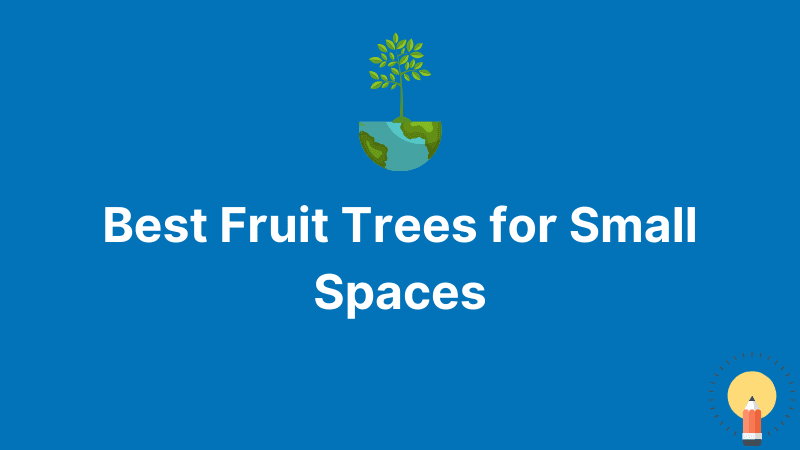(Full List) Best Fruit Trees for Small Spaces
Green beans, herbs, and tomatoes are among the first things that come to mind when you think about producing food in tiny areas. You may consider all of the veggies you can plant along your patio or back porch, but you may not consider how to cultivate fruit in short places.
The concept of strolling through your own fruit orchard may evoke lovely images, but most of us lack the room to do it. You can produce fruit even if you don't have enough room. Most fruit trees can climb on walls or are available in tiny sizes. Even the tiniest garden has enough area to produce some fruit each year.
So, when you're thinking about what you can cultivate in your little area, don't rule out fruits. Homegrown fruit needs a few steps. First, determine which fruits you want to cultivate and where you want to place the plants. Gardeners must next learn how to properly care for fruit trees.
Sounds simple enough, doesn't it? Yes, it is! Continue reading to find out more.
Fruits You Can Grow in Small Spaces
Many fruits could well be grown in tiny settings, but seek for dwarf varieties or those that adapt to less room. When you intend to cultivate fruit, the first step is to choose the appropriate fruit. Begin with fruit that you are already familiar with, such as apples. When you can check that fruit off your shopping list, you'll feel successful. Then, move on to fruits that you don't consume as frequently but would want to try.
Must Read:
1. Small Fruit Trees
Whenever people imagine about fruit trees, we see gigantic trees that take years to develop and bear fruit. While you may go that path, it's not a smart option if you're short on space. Instead, seek for little fruit trees, often known as dwarf trees, that were grafted and organically developed into small trees yet provide large harvests.
There are various options for little fruit trees, including:
1. Fig
2. Pomegranate
3. Mulberrie
4. Apple
5. Pear
6. Plum
7. Cherrie
8. Peache
9. Apricot
10. Nectarine
In a tiny place, dwarf fruit trees are your best friend. Because of their modest size, these trees don't need much trimming and provide fruit in less than two years. There will be no more 5-year wait for fresh apples. The fruits are the same size as those seen on a typical fruit tree. There's no need for ladders when it comes to harvesting!
2. Vining Fruits
Vertical farming is becoming more popular as more individuals want to raise their own food. Vining plants, whether veggies or fruits, are among of the greatest alternatives if you have limited space. Vertical gardening makes a lot of sense, and making use of walls is a good concept.
Vining fruits could well be done in a variety of ways, including:
1. Grape
2. Kiwi
3. Passion fruit
If you reside in a very cold area, such as Canada or Maine, you will need to hunt for cultivars that are best adapted to those conditions. Passion fruits, on the other hand, are sensitive to frost and must be cultivated in backyards in warmer areas or taken inside during the colder months.
3. Citrus Fruits
Citrus are the simplest of all fruit trees to cultivate in containers, which may surprise you. Dwarf citrus trees are now available. You probably never considered citrus for your patio or residence, but it is, particularly in the proper location.
It's important to note that the smaller the fruit, the better it performs in containers. Fruits like Meyer lemons, Satsuma mandarins, and kumquats are ideal for pots, but any citrus fruit tree may be pruned to be smaller. You may graft onto a rootstock as well.
4. Berries
Berry are the first fruit that many gardeners seek to cultivate. They're simple to make and have interesting tastes and textures. Berries are high in antioxidants, vitamins, minerals, and other beneficial nutrients. Furthermore, there are several alternatives for growing in tiny spaces:
1. Strawberrie
2. Blueberrie
3. Blackberrie
4. Raspberrie
These trees produce a lot of fruit, however the berries are only available seasonally. Some strawberries are ever-bearing, which means they will give repeated harvests throughout the year. There will be lots of jams, nibbles, fruit leathers, and other goodies.
5. Pineapple
Did you guys know that pineapples are one of the simplest fruits to cultivate? They're tropical, but they can thrive inside near a sunny window, and pineapples don't mind being potted.
The only problem is that pineapples require a long time to develop in order to produce one fruit - nearly two years. So, unless you live in a tropical climate like Thailand, growing pineapples as a hobby is preferable than producing enough fruit to feed your family. Growing pineapples, on the other hand, is quite amazing.
6. Melon
Melons are quite easy to cultivate in pots. It is possible to grow honeydew, melons, cantaloupes, and watermelons. Technically, they are spreading vines, but we can teach them to climb fences, trellised walls, or wire cages. Melons have the ability to form arches and stakes.
Melons, unlike the other alternatives, are not perennials and must be planted each year. The good news is that melon seeds are completely free. Each melon has dozens of seeds, so planting the next year should be no trouble.
Methods to Grow Fruit in Small Spaces
Now that you have an understanding of the numerous sorts of fruits you may produce in your area, you must consider the various methods for growing fruit in tiny places. Let's have a look at the options available to you.
Grow in Containers
Most fruit does well in containers, especially if you live in an area that has frost. Tender plants, such as lemons, need to be brought inside when it starts to frost.
Containers work well for fruits because growth is restricted. The roots are only able to grow so deep, which sends the right of the energy into fruit production. The plants are unable to reach their typical size.
Grow Up Walls
You may instruct dwarf trees to grow up walls, trellises, and other areas of your garden if you cultivate them. You must cajole them into the shapes required to conserve space and promote fruiting. The second option is to purchase pre-formed animals or train them yourself.
For peaches, apricots, and cherries, a fan form is preferred. Apples and pears prefer an espalier form, although both need a substantial wall.
Growing in cordons, which are trees trained into a single stem and bent at 45 degrees, is the greatest option for limited areas. Cordons are normally performed in a set order.
6 Tips to Grow Fruits in Small Spaces
Now, you have your fruit and you have where you want it to grow. You might pick several of these methods, such as creating a few edible arches and using containers on your patio. Don’t feel limited.
Growing fruit can be a bit tricky. They don’t always have the same nutrient requirements as vegetables, and you do have to spend more time pruning fruit trees and bushes. Here are a few tips to get you started!
1. Learn How to Prune
Fruits tree must be trimmed, although vegetable plants require little or no sunshine. Fruit bushes and trees that are pruned appropriately and at the right time will keep the plants modest while fostering a plentiful yield. It is critical that you take the time to understand how to trim each of the plants you are cultivating. Otherwise, you risk having a poor crop.
2. Fruits Need Plenty of Sun
All fruit trees, particularly citrus fruits and other subtropical or tropical fruits, demand a sunny site. Fruit such as blueberries, blackberries, raspberries, gooseberries, apples, and rhubarb may be grown in a somewhat shaded garden. Tender fruits, such as kiwi and mandarins, should not be attempted to cultivate.
3. Stake Your Young Trees
Young trees have shallow roots, which means it’s vulnerable to damage caused by heavy winds. A windy can could uproot your brand new tree. So, you need to keep it securely staked for at least the first few years.
Staking a tree is easy. Just put two wooden stakes into the ground on opposite sides of the trunk. Use tree ties or elastic material to wrap a figure eight loop between the trunk and stakes. You want the ties to be tight but loose enough that the tree bends a bit with the wind. It needs space to grow as well.
4. Use the Right Container
If you choose to grow in a container, be ensure you have the proper container. A 15-gallon container is big enough for most dwarf fruit trees but tiny enough to transport on your own. Fiber pots are the greatest option since they are lightweight, do not overheat in the sun like plastic pots, and allow for ample of air circulation for the roots.
5. Think About Pollination
Fruit trees often need pollinators, such as bees, bats, or other beneficial insects, to fertilize flowers and help ‘set’ the fruit. Other fruit trees require you to have more than one tree to cross-pollinate. This can be an issue if you want a variety of fruit trees in a small space or only have space for one. No pollination equals no fruit, and that would be a bummer.
So, your solution is to look for fruit trees that are labeled ‘self-fertile’ or ‘self-pollinating.’ It should be on the description or tag of the tree. You might look for self-fertile citrus, figs, peaches, nectarines, or apricots. Also, multi-grafted trees, such as mandarins and lemons on one tree, are usually self-fertile.
6. Use the Right Soil
You would not want to walk outdoors and dig up dirt for your potted plants. That's a terrible concept. If it contains too much water, you will spread illnesses and bugs. Instead, use a bagged potting soil with additives like peat or coir, vermiculite, and mature compost.
Growing Fruit in Small Spaces
Cultivating fruit is a possible even if you just have a balcony or a little lawn. You'll have a plentiful harvest, enough to wow your friends and family, provided you choose the correct fruit to grow – which should be foods you consume on a regular basis – and how you want to grow them.






